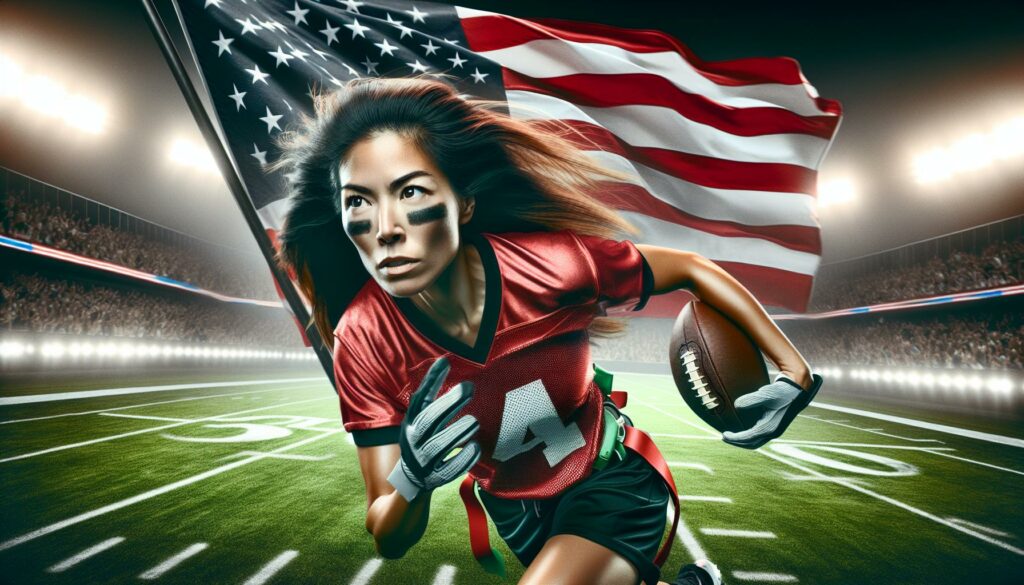I’ve watched flag football evolve from a casual backyard sport into an Olympic-worthy phenomenon. The inclusion of flag football in the 2028 Los Angeles Olympics marks a groundbreaking moment for this fast-paced, non-contact version of America’s favorite sport.
As someone who’s followed USA Flag Football Olympics journey in international flag football competitions, I’m thrilled to see this dynamic sport finally getting its Olympic spotlight. The American squad has dominated global championships, showcasing the perfect blend of speed, strategy and skill that makes flag football such an exciting spectacle. With NFL stars like Michael Vick having endorsed the sport’s Olympic bid, it’s clear that flag football’s time has come to shine on the world’s biggest sporting stage.
Key Takeaways
- Flag football will make its Olympic debut at the 2028 Los Angeles Games, marking a historic milestone for this non-contact version of American football
- The sport evolved from military training exercises in the 1940s to reach 6.5 million players across 8,200 leagues in the United States by 2020
- Team USA is a leading medal contender, with strong international competition from Mexico, Panama, and European teams like Austria and Denmark
- The Olympic tournament will feature 8 teams per gender division playing 5v5 format on 70×30-yard fields with standardized rules and a week-long competition structure
- USA Flag Football Olympics inclusion is driving significant global growth, with programs now operating in 72 countries and youth participation increasing 40% since 2020
USA Flag Football Olympics
Flag football emerged as a safer alternative to tackle football in the American military during World War II. The sport evolved from informal military training exercises into an organized recreational activity.
Origins and Early Development
Flag football originated on military bases in the 1940s as a training method for servicemembers. The U.S. Armed Forces developed standardized rules in 1942 to promote physical fitness without the injury risks of full-contact football. Key developments include:
- Creation of designated flag positions on players’ hips
- Implementation of specific field dimensions (60-80 yards)
- Establishment of 7v7 or 9v9 team formats
- Introduction of timing rules (40-minute games)
Rise in Popularity
The sport experienced significant growth during the post-war period through several channels:
- Integration into school physical education programs in 1950
- Formation of recreational leagues across 35 states by 1960
- Launch of national tournaments in 1975
- Adoption by the YMCA network in 1980
Notable participation milestones:
| Year | Number of Players | Number of Leagues |
|---|---|---|
| 1970 | 250,000 | 1,200 |
| 1990 | 2.8 million | 4,500 |
| 2020 | 6.5 million | 8,200 |
The NFL’s official support in 1996 marked a turning point, establishing youth programs nationwide. Through partnerships with schools, community centers, and sports organizations, flag football transformed from a casual activity into a structured competitive sport.
Flag Football’s Olympic Journey
The path to Olympic recognition for flag football represents a strategic collaboration between sports organizations worldwide. International partnerships paved the way for flag football’s inclusion in the 2028 Los Angeles Olympics.
International Federation of American Football
The International Federation of American Football (IFAF) leads global flag football development through standardized regulations across 72 member nations. Since its establishment in 1998, IFAF organizes premier events like the Flag Football World Championships where teams from diverse regions compete in men’s women’s divisions. The federation’s development programs have expanded participation by 300% since 2016 reaching 20 million players globally.
| IFAF Statistics | Numbers |
|---|---|
| Member Nations | 72 |
| Global Players | 20M |
| Growth Rate | 300% |
| Major Events | 5 |
Olympic Recognition Process
The International Olympic Committee (IOC) approved flag football for the 2028 Olympics through a multi-stage evaluation process in 2023. Key milestones include:
- Gaining provisional IOC recognition in 2013
- Achieving full IOC membership status in 2021
- Completing venue requirements assessment in 2022
- Securing technical official certification programs
- Establishing anti-doping compliance protocols
- Youth appeal across global markets
- Gender equality in competition formats
- Sustainable venue requirements
- Broadcasting potential
- Cultural relevance in host country
Team USA Flag Football Program
Team USA’s flag football program represents the nation’s elite competitive infrastructure for Olympic-level flag football development. The program operates under USA Football’s governance with direct support from the NFL.
National Team Selection
USA Football implements a three-tier selection process for identifying national team talent:
- Conduct regional combines across 8 major U.S. cities to evaluate player performance metrics
- Hold invitation-only national trials featuring 200 top performers from regional events
- Select 30 athletes (15 men 15 women) through position-specific evaluations focusing on:
- Speed measurements (40-yard dash 5-10-5 shuttle)
- Catching ability assessments
- Route-running precision
- Flag-pulling efficiency
- Strategic gameplay understanding
- Execute 6-month intensive training camps at the Olympic Training Center in Colorado Springs
- Practice specialized offensive formations:
- No-huddle spread attacks
- Option-based schemes
- Red zone packages
- Implement defensive strategies:
- Zone coverage systems
- Man-to-man techniques
- Rush timing coordination
- Utilize performance analytics through:
- GPS tracking devices
- Speed gate measurements
- Video analysis sessions
- Participate in international competitions:
- IFAF Continental Championships
- World Games tournaments
- Exhibition matches against top-ranked nations
Impact on American Football Growth
Flag football’s inclusion in the 2028 Olympics creates transformative opportunities for American football’s global expansion. The sport’s Olympic status opens new pathways for development across international markets while strengthening domestic participation.
Global Expansion Opportunities
The NFL’s international growth strategy leverages flag football as an entry point into emerging markets. Flag football programs operate in 72 countries with established partnerships between the NFL, IFAF, and local sports organizations. Key expansion metrics include:
| Region | Active Programs | Annual Growth Rate |
|---|---|---|
| Europe | 2,500+ | 25% |
| Asia-Pacific | 1,800+ | 35% |
| Latin America | 1,200+ | 30% |
International broadcasting rights for flag football competitions increased by 45% since the Olympic announcement, reaching 85+ countries. The NFL’s Flag Football World Tour events attract 50,000+ participants annually across 15 major cities.
Youth Development Programs
Youth engagement in flag football demonstrates significant growth through structured development pathways. The NFL FLAG program connects with 500,000+ young athletes through:
- Certified coaching programs reaching 15,000+ youth instructors
- School-based initiatives integrating flag football into 8,000+ physical education curricula
- Regional tournaments featuring 2,500+ teams across different age groups
- Performance development camps led by former NFL players in 200+ locations
- Digital training resources accessed by 100,000+ registered users
These programs produced a 40% increase in youth participation since 2020, with equal representation across gender demographics. The Olympic pathway creates additional incentives for young athletes, driving a 55% surge in competitive league registrations.
Olympic Format and Rules
Flag football in the 2028 Olympics follows a structured format designed to maximize competition while maintaining the sport’s fast-paced nature. The tournament integrates specific rule modifications to align with Olympic standards while preserving the core elements of traditional flag football.
Competition Structure
The Olympic flag football tournament features 8 teams in both men’s and women’s divisions competing across 7 days. Teams play in a round-robin group stage followed by single-elimination knockout rounds leading to medal matches. Here’s the breakdown:
- Group Stage: 2 pools of 4 teams each play 3 games
- Quarterfinals: Top 2 teams from each pool advance
- Semifinals: Winners compete for gold medal spots
- Medal Rounds: Bronze medal game precedes gold medal match
- Game Duration: 2×20-minute halves with running clock
- 5v5 player format on a 70×30-yard field
- No contact blocking permitted
- 4 downs to cover 20 yards for a first down
- 60-second play clock between downs
- 1-point conversions from 5 yards
- 2-point conversions from 10 yards
- Direct snap requirement to quarterback
- Players wear standardized flags at hip level
- 2 one-minute timeouts per half
- Overtime uses college-style alternating possessions
| Tournament Phase | Number of Games | Duration (Days) |
|---|---|---|
| Group Stage | 12 | 3 |
| Quarterfinals | 4 | 1 |
| Semifinals | 2 | 1 |
| Medal Rounds | 2 | 1 |
Medal Prospects for Team USA
Team USA stands as a leading contender for gold medals in both men’s and women’s flag football at the 2028 Olympics. The national teams’ track records in international competitions position them among the elite competitors in this inaugural Olympic event.
Top International Competitors
Mexico emerges as Team USA’s primary challenger, having won 3 IFAF World Championships in men’s flag football since 2012. Panama’s women’s team claimed the 2021 IFAF championship title demonstrating their competitive edge. Other notable contenders include:
- Austria’s men’s team with 4 European championship titles
- Canada’s consistent podium finishes in continental championships
- Denmark’s rising program with 2 Nordic championships
- Italy’s emerging strength in European competitions
- Japan’s technical precision earning 3 Asian championships
- NFL partnership providing elite coaching resources
- Advanced analytics system tracking 15 performance metrics
- State-of-the-art training facilities in 12 regional centers
- Deep talent pool with 6.5 million active players
- Professional development through NFL Flag operations
- Established pipeline of collegiate flag football athletes
- Home field advantage at the Los Angeles Olympics
| Team USA Performance Metrics | Statistics |
|---|---|
| International Wins (2020-2023) | 42 |
| Win Percentage | 87% |
| Average Points Per Game | 35.8 |
| Defensive Stops Per Game | 6.2 |
| Player Pool Size | 6.5M |
| Regional Training Centers | 12 |
Flag Football
I’m thrilled to see flag football taking its rightful place in the Olympic spotlight. The sport’s journey from military training grounds to the 2028 Los Angeles Olympics showcases its incredible evolution and growing global appeal.
With Team USA’s strong performance record and the NFL’s continued support I believe we’re witnessing the dawn of an exciting new era for this dynamic sport. USA Flag Football Olympics will undoubtedly inspire millions more athletes to embrace flag football’s unique blend of strategy speed and skill.
The future of flag football looks brighter than ever and I can’t wait to see our athletes compete for gold in Los Angeles. This Olympic debut marks just the beginning of what promises to be an extraordinary chapter in American sports history.

